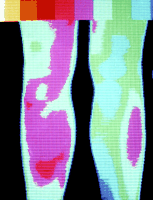This week in the BMJ
Volume 327, Number 7423, Issue of 8 Nov 2003Deep vein thrombosis is most likely within two weeks of long flights
Common antimalarial regimens are well tolerated
Systematic reviews unevenly cover the global burden of disease
Portable technology can improve learning in evidence based medicine
Duration of children's illness is often underestimated
Excessive and unsafe injections pose public health problem
Brief training in primary care does not lead to weight loss in obese patients
Deep vein thrombosis is most likely within two weeks of long flights
An aeroplane passenger has four times the risk of venous thromboembolism, but only in the first two weeks after a long haul flight. Kelman and colleagues (p 1072) linked hospital records for 5408 patients admitted to hospital with venous thromboembolism to arrival data for international flights during 1981-99 in Western Australia. They conclude that for most passengers the risk of venous thromboembolism after a long haul flight is small and that the average risk of death from flight related venous thromboembolism is around 1 per 2 million flights.
|
Common antimalarial regimens are well tolerated
Doxycycline and combined atovaquone and proguanil are the best tolerated of four recommended antimalarial regimens. In a randomised double blind controlled trial Schlagenhauf and colleagues (p 1078) assessed chemoprophylaxis in more than 600 non-immune travellers to sub-Saharan Africa. A high proportion of participants reported adverse events. Skin problems were more common in travellers taking chlorequine and proguanil, and patients taking mefloquine had more neurophysiological adverse events.
Systematic reviews unevenly cover the global burden of disease
Systematic reviews follow the priorities of rich countries rather than global disease burden. Swingler and colleagues (p 1083) analysed nearly 3000 reviews from the Cochrane database of systematic reviews (CDSR) and the database of abstracts of reviews of effects (DARE), and looked at the correlation between number of reviews and burden of disease. They found that the number of systematic reviews is still small and ignores major diseases affecting large numbers of the world population.
Portable technology can improve learning in evidence based medicine
Rapid access to valid evidence using portable technology may help improve learning of evidence based medicine in medical students. In a randomised controlled trial including 169 fourth year medical students from Hong Kong, Leung and colleagues (p 1090) tested the educational effectiveness of a computerised support tool against a pocket-sized card containing guidelines for clinical decision making. They found that rapid access to evidence on a portable computing device can improve medical students' learning of evidence based medicine and increase their confidence in clinical decision making.
Duration of children's illness is often underestimated
Doctors often tell carers that children with suspected acute viral infection of the upper respiratory tract will get better quickly, but less than half recover within four days. In a secondary analysis on 290 children from a randomised trial Butler and colleagues (p 1088) found that four days after the initial consultation 56% of the children were still unwell. The percentage decreased to 26% on the 7th day and to 6% by the 14th day. The authors believe that giving carers this information will help them to know what to expect and will reduce the need for further consultations.
Excessive and unsafe injections pose public health problem
Overuse of injections and unsafe practices are still common in developing and transitional countries. Hutin and colleagues (p 1075) reviewed published studies and unpublished reports to describe the frequency and safety of injection practices worldwide. They found that up to 75% of injections were given with reused, unsterilised equipment. The authors say there is an urgent need to improve injection practice to prevent unnecessary infections.
|
Brief training in primary care does not lead to weight loss in obese patients
Training general practitioners and practice nurses on the management of obesity does not result in weight loss in their obese patients. In a cluster randomised trial that included 635 patients, Moore and colleagues (p 1085) evaluated the impact of a 4.5 hour training programme on weight management in 44 general practices in the United Kingdom. Although the staff had better knowledge of weight management strategies, these were seldom used and did not affect patients' weight loss.
|


